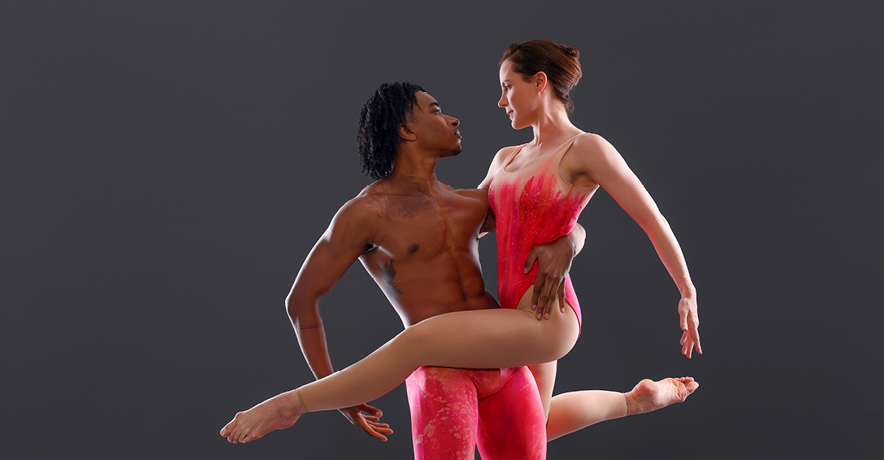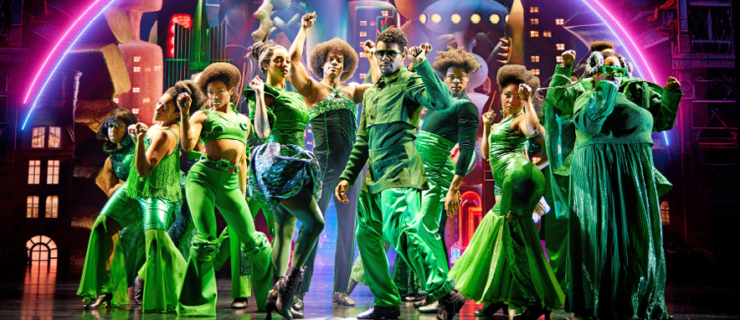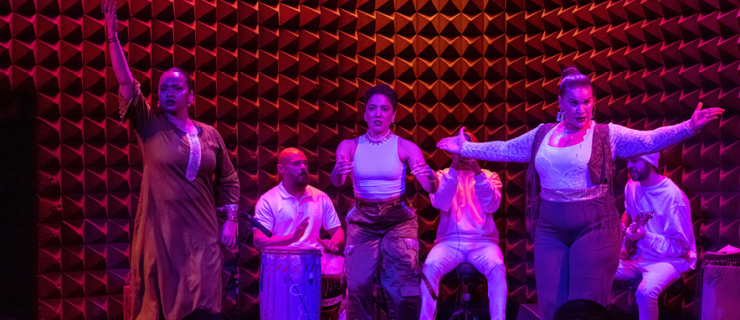Moving Into the Future: A New Era Dawns at Paul Taylor Dance Company
The past several years have brought momentous change to the Paul Taylor Dance Company: a new director, a wave of new hires, a pandemic, the naming of a choreographer in residence, all since 2018. It seems that the company has emerged from the pandemic with a new sense of mission, though with its core of fundamental values intact.
It all started in May 2018, with the surprise announcement of a young director-in-waiting, Michael Novak, selected to take the reins after the eventual death of the company’s founder and creative force, Paul Taylor. Novak was only 35, and still at the height of his dancing career.
The decision, made by Paul Taylor himself, turned out to be judiciously timed: That August, Taylor passed away at the age of 88. Six dancers, many of whom had been dancing for Taylor for over a decade, announced their departures within the year. “There was a sense that Paul would live forever,” says Eran Bugge, who had joined the company in 2005 and opted to stay. With Taylor’s passing, one era ended and a new one commenced. For several of the dancers, this seemed like a natural moment to retire.
But just as a group of dancers chosen by the new director—one that included the quietly engrossing Devon Louis and the focused and incisive Maria Ambrose—was finding its place in the company’s ranks, the pandemic hit. Novak, a thoughtful, measured person in general, was still in the process of shaping his leadership and making plans. The question now was not just how to lead the company into the future, but how to keep it alive in the present. There was no precedent, no model to follow. “I was reaching out to older friends and mentors in the field, and asking for advice,” he says, “and these people, in all their wisdom, didn’t know what to do. No one had navigated anything like this before.”

This moment of truth became his crucible. “I felt an immediate responsibility for the survival of the artists in the company,” Novak says. The immensity of the task sharpened his sense of purpose and focus, and led to a series of initiatives designed to keep the dancers in touch with each other and engaged with the work. The results were apparent at the company’s spring season at New York City Center this March: a reinvigorated company, full of new faces, buoyed by a youthful energy and a freshness of approach. “It’s a whole new group of personalities,” says Andy LeBeau, one of three rehearsal directors at the company, along with Bettie de Jong and Cathy McCann. “They’re passionate and open, not tied to doing things a certain way. And they really get along well.”
The process of forming bonds in a company like Taylor usually happens during rehearsal periods and, especially, over the course of long tours, when understudies get to try out new roles and watch their colleagues night after night from the wings. Newer dancers learn from more senior artists, who help to transmit choreographic details and subtleties of style. It is, Bugge says, one of the reasons she decided to stay. “I wanted to make sure that the things that make the work and the company special, like the way the dancers look at each other or take each other’s hands onstage, got passed on.”
When performing and touring became impossible because of the pandemic, Novak came up with new ways to keep the dancers engaged. There were homework assignments via Zoom, in which dancers learned solos at home and then received virtual coaching from LeBeau, McCann and Taylor’s longtime right-hand-woman de Jong, who joined the company in 1962. Additional dancers from the Taylor alumni network were also brought in to coach and give virtual advice. At times, “We’d Zoom with the person who originated a particular role, and hear their stories,” says Bugge.
The online sessions proved crucial to newer company members like Louis, who was able to try out Taylor’s fluid, muscular solo from his 1962 dance Aureole. Learning it, Louis says, gave him a new insight into the coordination and flow that undergirds much of Taylor’s choreography. “It’s like you’re learning from the master himself,” he says.
Other Zoom workshops focused on the best approaches to teaching Taylor style and repertory, and in weekly discussions with alumni, the dancers would delve into a certain work from the repertoire, teasing out what made it tick. While the Taylor company has always had a particularly robust relationship with former dancers, technology took it to a new level—a large screen is now permanently available in the rehearsal studio to facilitate remote coaching sessions as needed.
Just as importantly, Novak was determined to get the dancers back in the studio as soon as it was feasible and safe. To this end, he created rehearsal and choreographic bubbles as early as fall of 2020. In-person participation was voluntary, and the sessions took into account the contingencies of life during lockdown. “We had dancers who needed to be home taking care of family members,” remembers Novak, “but we also had dancers who needed to be in the studio.” The dancers who were able to take part were put in groups of six, rehearsing in alternating sessions throughout the day. It was in this setting that the choreographer Lauren Lovette first began working with them.

Novak had had his eye on Lovette since seeing Not Our Fate, a piece she created in 2017 for New York City Ballet, then her home company. (Lovette retired from her principal dancer position there in 2021.) “I saw musicality, I saw craft, and I felt there was a rebel in there that was trying to push the artform forward,” says Novak. “I remember wondering what she would do with modern dancers.”
It turned out that Lovette clicked, both with Novak and with the company. “It’s a joy to have her in the studio,” says Louis. “She comes in very fresh and excited to try things.” The feeling, Lovette says, is mutual: “The Taylor company is like a focused playground. Every time I leave that studio, I feel lighter and more inspired and alive.” She is amazed by the dancers’ individuality, the way each shapes the movement according to their physicality, phrasing and personality. This, in turn, shapes what she choreographs for each of the dancers. (Taylor was famous for doing this as well.)
The relationship flourished to such an extent that in mid-March, Lovette became the first choreographer in residence in the company’s 68-year history, a position that commits her to creating at least one work per year for the next five years. Both she and the dancers have much to gain: For the dancers, it means having a continuous presence in the studio, someone who understands the way they move. For Lovette, it is a laboratory in which to hone her voice and explore movement far beyond the ballet vocabulary in which she was trained.
But she is hardly the only choreographer the dancers will be working with. Creation plays a central role in the company’s new mission, and the pandemic, with fewer tours and performances, offered a particularly fertile period in which to bring in choreographers. “I wanted to come out of the pandemic showing audiences and patrons that this is a new era of the Taylor company,” says Novak. In 2022, the company is premiering works by Michelle Manzanales, a Mexican American choreographer and teacher associated with Ballet Hispánico; Peter Chu, who heads his own contemporary company in Las Vegas; Amy Hall Garner, a Juilliard graduate who has made work for Ailey II and the ABT Studio Company; and Puerto Rican choreographer Omar Román de Jesús. The diversity is intentional. “Paul Taylor brought many facets of humanity to the stage,” says Novak, “but I don’t think he brought all of them to the stage.”
This desire to open the company to a wider range of experience is also reflected in the selection of new dancers. The world of American modern dance has historically been more white than many care to admit, and though the Taylor company has always included dancers of diverse backgrounds and ethnicities, Novak is actively putting diversity at the forefront. “I want to create a company that offers opportunities for students and patrons to see their own stories on the stage,” he says. There are currently more dancers of color at the company than ever before.
The dancers’ backgrounds are also varied, and in many cases do not include passage through the traditional Taylor II pipeline. Shawn Lesniak danced for a variety of choreographers and companies, including Trey McIntyre and Parsons Dance, before joining. John Harnage was a member of Jessica Lang Dance. Louis, who studied at The Ailey School and was a member of Ballet Hispánico’s junior company, had taken a single summer intensive in Taylor technique before joining; in hiring him, Novak was less interested in Louis’ Taylor bona fides than in his personality and a particular quality he saw in his dancing: “I hired Devon because of his warm spirit, quiet confidence, stunning ballon and remarkable fluidity,” Novak says. With his subtle intensity and silken way of moving, Louis made a strong impression in Kyle Abraham’s 2019 work for the company, Only the Lonely.

The upshot of all this change is the emergence of a company that is more diverse, and more versatile, than ever before. Taylor dancers are ready to take on the movement style of any creator, and to tackle works from different eras and traditions. In April, for example, the company performed Kurt Jooss’ expressionist work The Green Table, an important antiwar ballet created in Germany in 1932, the year before Hitler was appointed chancellor. The elegant Lesniak was riveting in the role of Death. (Sadly, this ballet has become newly relevant.) And in June, the company revived some of Taylor’s very earliest dances, including Events II, from his first-ever full evening of dances in 1957, and an excerpt from Images and Reflections, from the following year. These youthful experiments in movement, theatricality and response to music require a very different approach than that involved in dancing Aureole or Esplanade, or in Lovette’s creations, for that matter.
All this change represents an important evolution for the company as it navigates a new era, without the comforting presence of Paul Taylor. And, it seems, the company is ready. The fundamentals have not changed, Novak assures. But “what feels different for me,” he says, “is that there’s a sense of ownership of the fact that we are the post-pandemic company. This is the dancers’ company now. They are ready to show up and welcome people into their world.”




